All-Seeing Eye: Military History Radar
The idea of using Hertz waves (as radio waves were once called) to track moving objects is not much younger than radio communication itself. Nine years after the first experiences of Marconi and Popov, she came to the head of 22-year-old Christian Hülsmeier, an employee of Siemens from Düsseldorf. He did not have a technical education, but was very interested in electrical innovations, in particular radio equipment. In 1904, he assembled, tested and patented a device that he called a telemobiloscope. According to the patent application, it was “an apparatus that radiates and receives Hertz’s waves and is designed to detect a metal body in its path, for example, a train or a ship, and warn of its appearance.” May 17 or 18 for the first time publicly presented him in Cologne on the bridge over the Rhine. The demonstration was attended by representatives of shipping companies, journalists and numerous onlookers. Both European and American newspapers reported a spectacular experiment without delay.
The Hulsmeier apparatus consisted of a spark generator of radio waves, a radiating antenna with a metal focusing reflector, a receiving antenna with another reflector, and a coherer as a receiver. With the help of an electric bell, he announced the approach of river ships. The device even approximately indicated the direction to the object, but, of course, could not determine its distance and speed. Strictly speaking, it was not a radar, but only a radio detector.
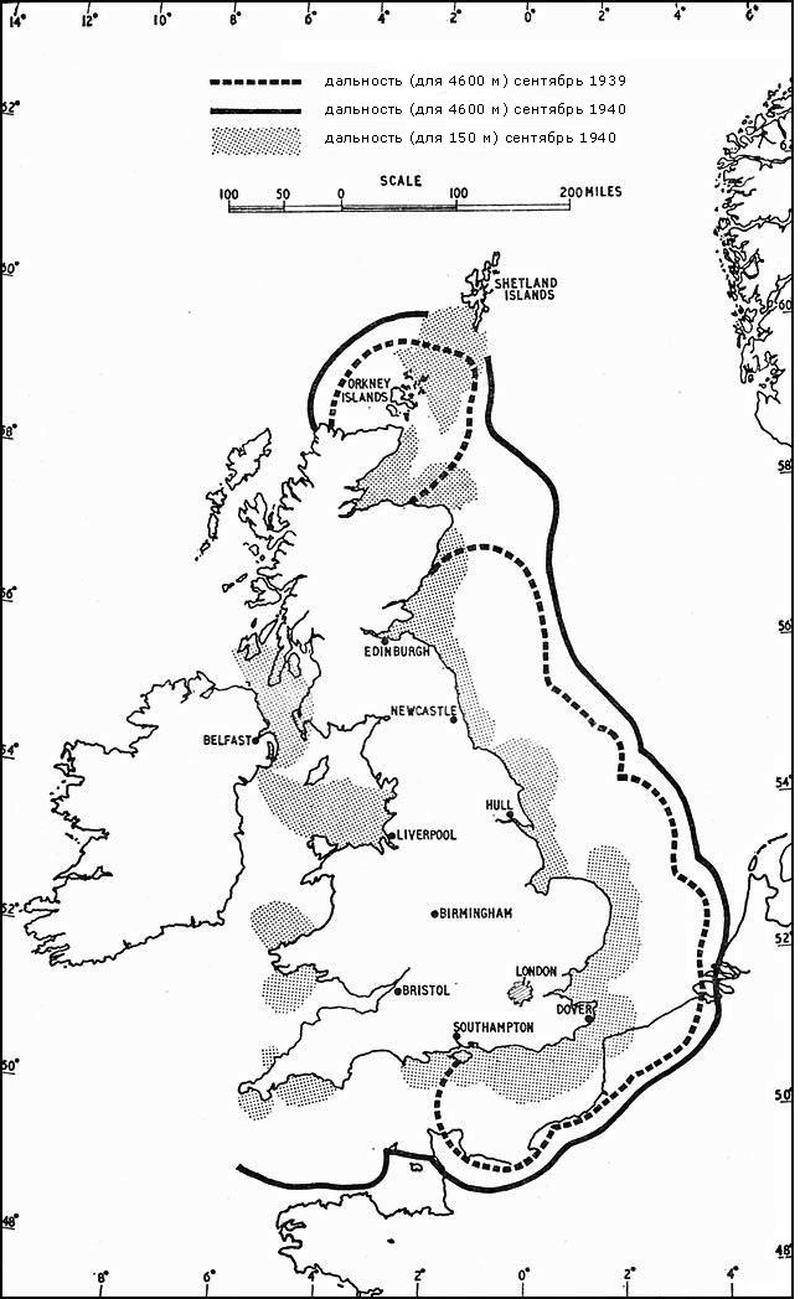
The first British radar network did not at all resemble modern radars. The usual rotating antennas were not in sight (they appeared later). The pulses of 13,6-meter radio waves with a length of 20 microseconds with 40-millisecond gaps were emitted by cable antennas suspended on trellised steel towers of 110-meter height (four for each station). The receiving antennas were mounted on the 70-meter towers of wooden structures located at a distance (to avoid interference). At first, the power of each transmitter was 350 kW, later it was brought up to 750 kW. Stations were located along the coast of the chain, which gave the name to the entire system - Chain Home. According to current concepts, its resolution was ridiculous - about 3 km, and besides, radars practically did not notice low-flying objects. However, in fine weather, they spotted Goering’s air armada already in the sky over France, which provided the British air defense with a 20-minute warning. In those conditions, it was of great importance. During the three-month Battle of Britain, the Germans lost almost half of their combat aircraft - 1882 of 4074. And although the total losses of the Royal Air Force were only slightly less (1547), the Germans lost a much larger number of pilots (544 English pilots against more than 3500 dead and captive Germans). In the future, the activity of the German Air Force in the airspace of Britain fell sharply and eventually came to naught. This was helped by the new Chain Home Low radar network, which already used rotating antennas emitting one and a half meter radio waves. And since 1941, radars operating on 50-centimeter waves appeared on the ships of the royal fleet. The battle for Britain was won, albeit at a very high price.
Hülsmeier suggested installing such devices on ships to prevent collisions in poor visibility conditions. Later, he even invented a device for automatically estimating the distance to an object by the angle of inclination of the receiving antenna, but he did not do so. And the telemobiloscope itself did not last long. Neither shipping companies, nor seamen of the Kaiser fleet were interested in them. The general opinion was that it was enough to signal beeps about the approach of ships and that the Hülsmeier equipment was complex, not very reliable and practically useless. It didn’t help even that on testing in Holland the device showed a very decent range in 3 km. In the summer of 1905, the inventor was also denied support by Telefunken, after which he put an end to his brainchild. Hülsmeier lived to see the 1957 year, patented 180 inventions, but never returned to his first job. However, when after the Second World War, the whole world was convinced of the capabilities of radar, Hülsmeier was recognized as an outstanding inventor in his homeland.
Of course, it is now clear that no one would be able to construct a real radar based on the first-generation radio technology based on spark generators and coherers or magnetic detectors. Hulsmeier came up with a great idea, but without a powerful vacuum (and then solid-state) electronics, she promised little - the German naval experts were not mistaken about this. Descendants remained only his device, now on display at the German Museum in Munich.
Over the ocean
In the fall of 1922, Albert Hoyt Taylor and Leo Yang from the US Naval Aviation Radio Engineering Laboratory detected a wooden vessel passing through the Potomac using radio waves. On one side was a transmitter with an antenna, continuously emitting waves of length 5 m, and on the opposite side - a receiver. When the ship was between the instruments, the receiving antenna received two signals - direct and reflected. As a result of interference, the original radiation was modulated in amplitude, and interference was superimposed on the even tone of the received signal. Like the Hülsmeier device, it was not a locator, but only a detector.
Taylor and Young submitted an application to continue their work, but did not receive approval. A year later, Taylor became head of the radio department of the newly established Naval Research Laboratory (Naval Research Laboratory, NRL), and he had to work on completely different projects. However, in the summer of 1930, his assistant Lawrence Highland found out that using radio waves you can detect airplanes. This happened because of pure luck: there was a flight field between the transmitter and receiver antennas. It was then that Taylor and convinced the authorities in the need to work on interference detectors. For three years they were engaged in these instruments at NRL, and then (due to apparent failure) they began to use real radars that received radio pulses reflected from the object. Created under the leadership of Robert Page, the first experimental pulse radar was tested only in 1936 year. In June, he caught the plane from the 40-km distance.
In the 1917 year, the great Nikola Tesla in an interview published in the highly respected journal The Electrical Experimenter, on the whole, quite correctly formulated the principle of radar and emphasized that this method would allow tracking the position and speed of moving objects. True, Tesla considered the use of standing waves to be more promising (he was mistaken in that), but he also allowed the use of radio pulses. He himself did not work in this direction, but many years later his idea found a follower in the person of French radio engineer Emile Girardot, who in 1934, patented a device for radiolocation. A year later, he installed his instrument on the Normandy, the largest transatlantic liner of the time. In 1939, the Girardot group mounted the first radar station in France for monitoring the airspace, which warned the Paris air defense forces of German raids. In June, 1940, just before the fall of Paris, the French destroyed their equipment so that it would not fall into the hands of the enemy. In the photo - the antenna of the first American serial radar SCR-268 with a detection range of 35 km.
In subsequent years, the development of radar equipment in the United States accelerated markedly, but it only took up operational duty after the start of World War II: on warships in 1940, on land air defense posts - from the winter of 1941. Just then, the US military invented the word “radar”, it was an abbreviation of RAdio Detection And Ranging (radio detection and assessment of the range).
German achievements
There are many German scientists among the pioneers of radar. A special place is occupied by the brilliant radio engineer and inventor Hans Erik Holmann, who has more than 300 patents. In 1935, he patented a multi-resonator magnetron capable of generating powerful centimeter-range radiation.
More simple versions of the magnetron were developed in 1920-x in several countries, including the USSR - by Kharkov radiophysicists Slutsin and Steinberg. But Holmann was not able to stabilize the radiation in frequency, so the Germans at the end of 1930 preferred more stable, although less powerful klystrons.
In Germany, the first experiments were carried out, aimed at the creation of pulsed military radars. In the year 1933, they were started by physicist Rudolf Kunhold, scientific director of the Institute of Communication Technologies of the German Navy. He worked with centimeter radio waves, and as their source he used the Barkhausen-Kurtz triode invented in 1920, which gave a radiation power of just 0,1 W. As early as September 1935, Kunhold demonstrated to Commander-in-Chief of the Navy Admiral Erich Raeder a perfectly functioning radar with an electron-beam display. By the end of the 1930-x, operational radars were created on the basis of it in the Reich - Seetakt for the fleet and Freya for air defense. A little later, German engineers designed the Würzburg radar fire control system, the first samples of which entered the army and the Air Force in 1940 year.
So, German radar developers could boast a considerable number of technical advances. However, the Germans began to use them later the British - though not the fault of the engineers. At first, Hitler and his entourage believed in a blitzkrieg, and the radar was considered mainly defensive. Locators of the Freya system even exceeded British radar in a number of parameters, but at the beginning of the war the Germans had only 8 of such stations, and during the battle for Britain they could not fully track the actions of British aviation. Since 1934, radar has been engaged in the USSR. Nevertheless, by the beginning of the war with Germany, the Soviet military had practically no ground defense radar, and they only began testing the Gneiss radar in 1942 a year.
Death rays
By the 1935 year in Germany, the United States, the USSR and France have already been serious developments in radar. Britain had nothing worthy. However, lingering at the start, the British overtook everyone at the finish.
In the summer of 1934, air maneuvers took place in England, demonstrating that the country does not have effective methods of defense against enemy bombers. It was then at the Ministry of Aviation that they recalled requests from time to time for creating devices for generating beams that were fatal to the crew of an attacking aircraft. Officials promised a premium of £ 1000 to someone who designs a device that can kill a sheep from a distance of 100 m. Passion was fueled by the newspaper New York Sun, which told the world that Nikola Tesla had invented a machine capable of shooting down 10 000 combat aircraft from a distance of 250 miles. The most interesting thing is that it was not a fantasy of journalists: Tesla really made such a ridiculous announcement, which should probably be attributed to the fact that the great inventor was already under 80.
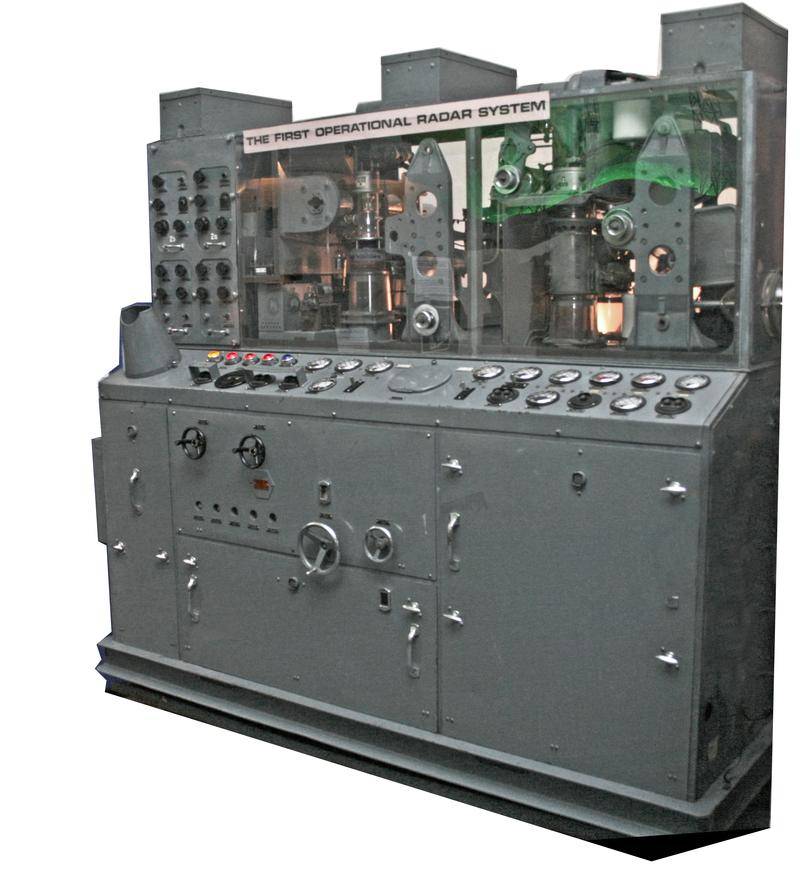
The British began developing radar just four years before the outbreak of hostilities. At the same time, they began with an absolutely fantastic project that did not have the slightest chance of implementation. However, they had the insight to consider it a rational grain, which sprouted in the world's first system of national radar protection. In good weather, the radar stations Chain Home intercepted German squadrons in the sky over France 20 minutes before they appeared. In those conditions it was of great importance.
Henry Vimperis, director of the Ministry of Aviation Research Department, did not believe this nonsense, but in January 1935 still asked the superintendent of the radio department of the National Physical Laboratory Robert Watson-Watt (by the way, a direct descendant of the inventor of the steam engine James Watt) to think about the radiator of electromagnetic waves affecting a person with distances of several kilometers. He doubted that it was possible, but promised to tackle the problem and instructed his employee, Arnold Wilkins, to perform the necessary calculations. Wilkins confirmed the conclusions of the chief, but did not stop there. Like many radio engineers, he was aware that a flying plane interferes with short-wave radio signals. Wilkins wondered if it was possible to catch the radio waves reflected from the plane body, and, to his considerable surprise, he received a positive response, which Watson-Watt reported to the authorities. It responded with unusual speed for the British bureaucracy and ordered to immediately test the idea in practice.
How Britain became an island
Wilkins did not have time to make a good generator of radio pulses and in the prescribed time only managed to assemble a receiver connected to the cathode tube. The signal source was the BBC antenna complex in Daventry, broadcasting on 49 meter waves that were emitted in a beam with an angular width of 30 °. During testing, radio signals were reflected from a twin-engine bomber, the Hayford biplane, circling at an 3-kilometer height. It was a radio interference detector, similar to what the Americans did several years earlier. On February 26 of 1935 of the year, he spotted an airplane from a distance of 8 miles (about 13 km), and Watson-Watt uttered a phrase that went down in history: “Britain has become an island again!”
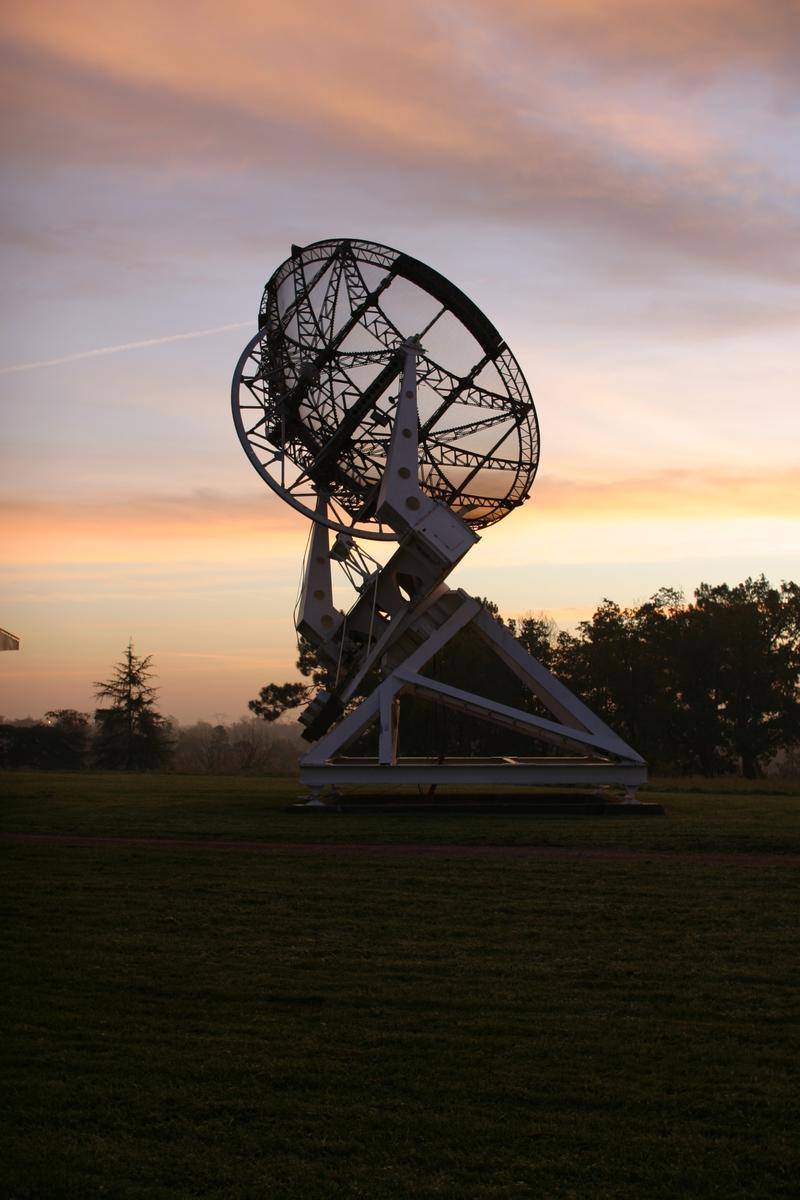
Further was a matter of technology and financing. Already in May, the British built a secret laboratory on the North Sea coast to calibrate and test real-weather radar equipment. 17 Jun. Watson-Watt, Wilkins and Edward Bowen, who joined their team, caught a seaplane flying through 27 km, and during further tests they increased the radius of the location to 65 km. In September, the British government gave the go-ahead to deploy the first five stations of the radar network, and in December the treasury allocated a very substantial amount for that time of £ 60 000. Technical progress was not inferior to the rate of financial injections - in 1936, the Watson-Watt team had already caught aircraft at a distance of 150 km. And 17 August 1937 of the year, the British successfully tested an aircraft airborne radar to track naval targets, designed by Bowen.
At the start of the 1937, English air defense had seven radar stations on the southeast coast. In September, these posts switched to around-the-clock mode. Before the start of the Second World War, the British already had 20 stations integrated into a single network, blocking the approach to the British Isles from Germany, Holland and Belgium. So a clearly impracticable generation of death rays turned into a development that helped Britain withstand the first critical months of the German bombardment.
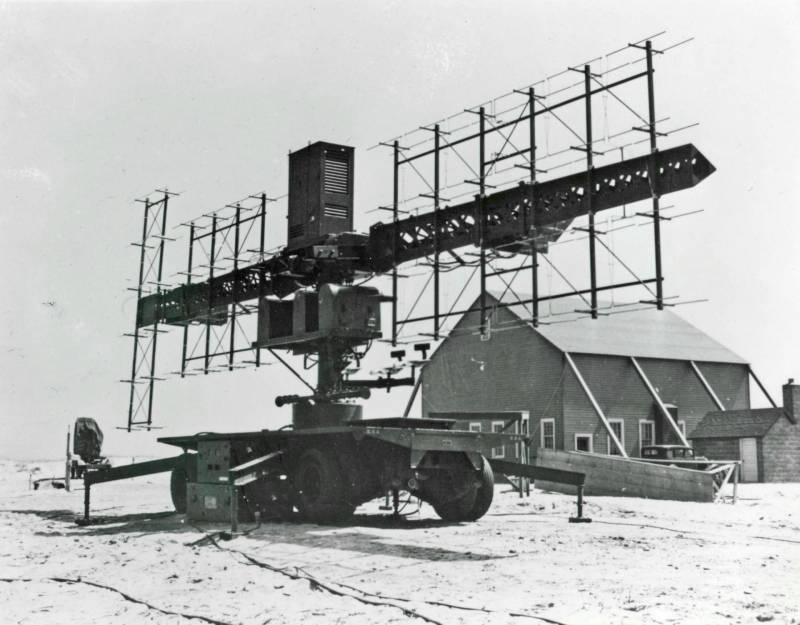
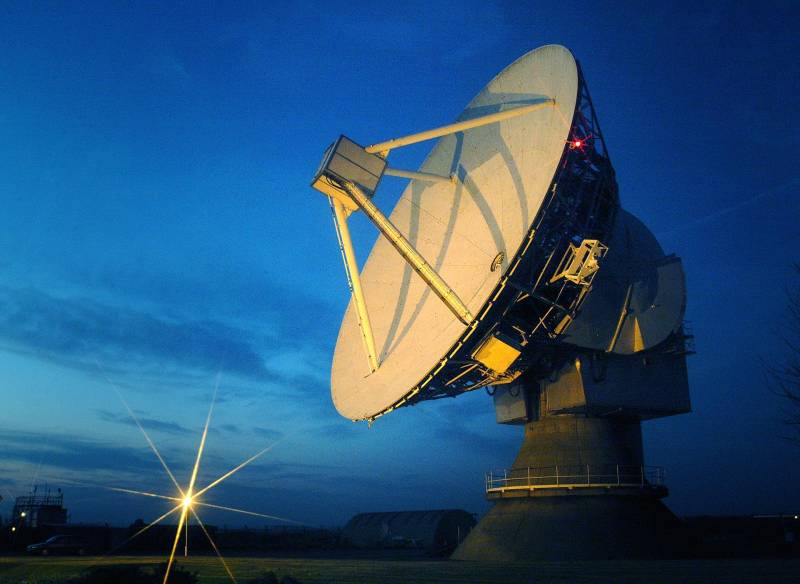
Information